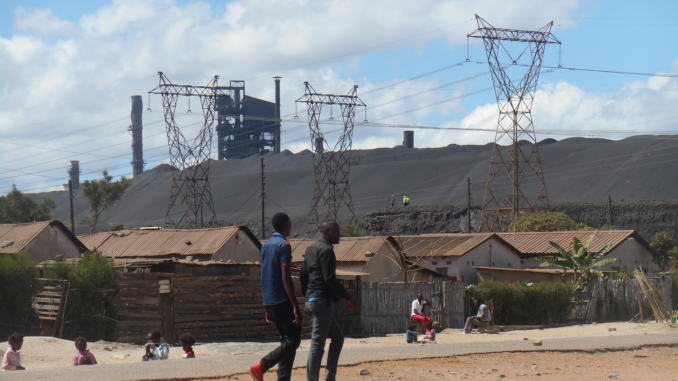
Report written by Iva Peša, Associate Member of History Faculty, Oxford and Research Associate in Environmental History, Comparing the Copperbelt project (Jan 17-Sep 19).
What are the parallels and differences between the environmental history of the Central African Copperbelt and extractive sites in Peru, Indonesia or Nigeria? A two-day workshop, ‘Extractive Industries and the Environment: Production, Pollution and Protest from a Global and Historical Perspective’ held at the University of Oxford on 6 and 7 December 2019, organised by myself and Corey Ross, delved into diverse case studies of resource extraction and its environmental dynamics. Funding from Oxford’s John Fell Fund brought together twenty scholars based in Latin America, Africa, Australia, Europe and the US to discuss how extractive industries rework local topographies, land use and vegetation patterns and introduce new structures and meanings to the environment. Oil extraction and coal, copper and gold mining move tonnes of earth, which profoundly impacts on and transforms the landscape, soils and watercourses near industrial areas. Nonetheless, scholarship on the historical linkages between extractive industries and environmental change outside of Europe and North America remains scarce and tentative. This workshop therefore looked at technologies of resource extraction, changing knowledge regimes towards pollution, as well as global protest movements that have flagged up environmental injustice. All contributions asked how extractive regimes have been shaped by transnational connections, through colonialism, capitalism and networks of knowledge.
This focus on transnational and comparative aspects allowed us to place the ‘Comparing the Copperbelt’ project in a broader, global perspective. Since its kick-off in Uppsala in 2016, the ‘Comparing the Copperbelt’ project has organised a large number of successful events, which mainly considered African case studies. Although this approach has enabled in-depth knowledge production and a better understanding of Copperbelt dynamics, there are many parallels to be explored with other extractive sites across the globe. The resemblance between Chuquicamata, Chile and Kitwe, Zambia goes beyond rich copper deposits, industrial mining technology or investment flows, and includes engineers, knowledge and ways to deal with environmental change. Hearing about lime extraction in Australia or about the interaction between British oil investors and pastoralists in Iran gave me new questions and perspectives to approach my own research.
The first session on imperialism and resource extraction featured papers by Susie Protschky and Ruth Morgan on sulphur and lime collection in the Dutch East Indies and Australia, whilst Corey Ross presented on tin mining in Southeast Asia as a subterranean frontier, a space where categories of race and productivity were defined. In the session on oil, culture and power, Guillemette Crouzet presented a fascinating paper on British-Bakhtiari interactions in Persia, Sarah Elkind talked about the tensions between oil drilling and going to the beach in Los Angeles, using vivid cartoons, whereas Olusegun Titus analysed how popular Nigerian musicians represent oil, multinationals and environmental degradation in the Niger Delta.
Subsequently, Manuel Méndez, Damir Galaz-Mandakovic and Manuel Prieto compared Chilean copper mining in Chuquicamata to Bingham Canyon in the US, highlighting knowledge production in these diverse but similar miningscapes. José Carlos Orihuela adopted a comparative political economy approach to show how mining in Chile, Peru and Colombia has been environmentalised differently. This workshop had several contributors from ICTA in Barcelona, who have all been working on the Environmental Justice Atlas (https://ejatlas.org/). Mariana Walter and Lucrecia Wagner explained why environmental protest in Argentina had been remarkably successful at stopping new mine development, whilst Joan Martínez Alier answered the question as to whether there is a global environmental justice movement in the affirmative. Struggles to correct environmental injustice are still isolated, but there are nonetheless examples of remarkable global connections. Juan Liu detailed environmental protest from a Chinese perspective.
Timothy LeCain set out a ‘Post-Anthropocentric Politics’, asking whether neo-materialist theory can provide solutions to the problems of global mining. He argued that our current societies are built on mining, but that we do not sufficiently acknowledge the materiality of extraction – despite its omnipresence. This was elaborated in the presentations by Gillian Gregory, who explored possibilities for post-extractivism in Latin America, and Anatolijs Venovcevs, who adopted an archaeological approach to post-Soviet mining landscapes. Do debates on the Anthropocene and climate change force us to think about a post-mining future and if so, what might this look like?
Urvi Khaitan and Vinita Damodaran presented papers on mining in India. Whilst Damodaran focused on the interaction between mining globalisers and tribal histories, Khaitan detailed histories of gender and labour in coal mining of the ‘Women Beneath the Surface’. Joseph Mangarella offered an excellent paper on oil extraction in Gabon and the pitfalls of environmentalism in a rentier state, whilst I explored how environmental values towards mining changed on the Zambian and Congolese Copperbelt. Can we trace environmental consciousness by looking at air, water or cleanliness? Finally, Nick Meynen presented his book ‘Frontlines: Stories of Global Environmental Justice’. This workshop was fortunate to have such engaged chairs and a supportive audience.
What can we learn by adopting a comparative approach to resource extraction? How can we globalise environmental histories of mining? The success of this workshop, as well as the workshop on the ‘Global History of Copper’ held in Trondheim in August 2019, show that these are pertinent questions that will continue to stimulate future research.
